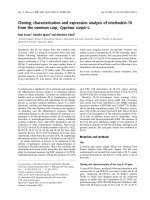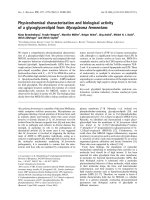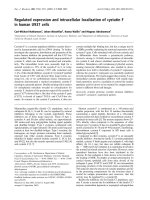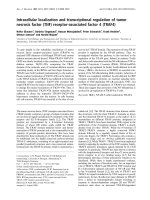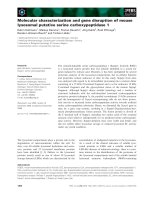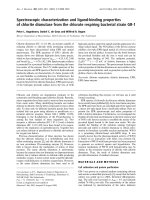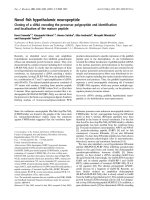Báo cáo Y học: Spectroscopic characterization and ligand-binding properties of chlorite dismutase from the chlorate respiring bacterial strain GR-1 ppt
Bạn đang xem bản rút gọn của tài liệu. Xem và tải ngay bản đầy đủ của tài liệu tại đây (380.29 KB, 7 trang )
Spectroscopic characterization and ligand-binding properties
of chlorite dismutase from the chlorate respiring bacterial strain GR-1
Peter L. Hagedoorn, Daniel C. de Geus and Wilfred R. Hagen
Kluyver Department of Biotechnology, Delft University of Technology, The Netherlands
Chlorite dismutase (EC 1.13.11.49), an enzyme capable of
reducing chlorite to chloride while producing molecular
oxygen, has been characterized using EPR and optical
spectroscopy. The EPR spectrum of GR-1 chlorite dis-
mutase shows two different high-spin ferric heme species,
which we have designated ÔnarrowÕ (g
x,y,z
¼ 6.24, 5.42, 2.00)
and ÔbroadÕ (g
z,y,x
¼ 6.70, 5.02, 2.00). Spectroscopic evidence
is presented for a proximal histidine co-ordinating the heme
iron center of the enzyme. The UV/visible spectrum of the
ferrous enzyme and EPR spectra of the ferric hydroxide and
imidazole adducts are characteristic of a heme protein with
an axial histidine co-ordinating the iron. Furthermore, the
substrate analogs nitrite and hydrogen peroxide have been
found to bind to ferric chlorite dismutase. EPR spectroscopy
of the hydrogen peroxide adduct shows the loss of both
high-spin and low-spin ferric signals and the appearance of a
sharp radical signal. The NO adduct of the ferrous enzyme
exhibits a low-spin EPR signal typical of a five-co-ordinate
heme iron nitrosyl adduct. It seems that the bond between
the proximal histidine and the iron is weak and can be
broken upon binding of NO. The midpoint potential,
E
m
(Fe
3+/2+
) ¼ )23 mV, of chlorite dismutase is higher
than for most heme enzymes. The spectroscopic features and
redox properties of chlorite dismutase are more similar to the
gas-sensing hemoproteins, such as guanylate cyclase and the
globins, than to the heme enzymes.
Keywords: chlorate respiration; chlorite dismutase; EPR;
ESR; heme enzyme.
Chlorate and chlorite are degradation products of the
commonly used bleaching agent chlorine dioxide. Recently,
micro-organisms have been used to remove these oxyanions
from waste water. Many denitrifying bacteria can reduce
chlorate to chlorite, but the latter compound is toxic to these
cells. To date only six different bacterial species have been
isolated that can grow using chlorate or perchlorate as a
terminal electron acceptor. Strain GR-1 (DSM 11199),
belonging to the b-subdivision of the Proteobacteria, is
among the best studied of these organisms [1]. Two
enzymes, a chlorate reductase (EC 1.97.1.1) and a chlorite
dismutase (EC 1.13.11.49), have been found to be respon-
sible for the respiration on (per)chlorate [1]. Together they
can reduce chlorate or perchlorate to chloride and molecu-
lar oxygen (see below).
Previous characterization of these enzymes has shown
that the chlorate reductase is a molybdenum and iron/
sulfur-containing enzyme [2], and the chlorite dismutase is
an iron protoheme IX-containing enzyme [3]. However,
little is known about the mechanism of action of these
enzymes. The name chlorite dismutase is unfortunate,
because the enzyme does not dismutate or disproportionate
chlorite, but it reduces chlorite to chloride while producing
molecular oxygen. A more correct name would be chloride–
oxygen oxidoreductase or chlorite oxygen-lyase. However,
as the name chlorite dismutase has been used in all
references describing this enzyme, we will also use it until
formal renaming.
EPR spectra of Ideonella dechloratans chlorite dismutase
have recently been published [4]. As for most heme enzymes,
the EPR spectrum shows an axial high-spin ferric signal and
a minor low-spin signal from a hydroxide adduct. Here we
present the EPR spectroscopic and redox properties of
GR-1 chlorite dismutase. Furthermore, we investigated the
binding of hydroxide and imidazole to the ferric enzyme and
of NO to the ferrous enzyme to establish the nature of the
proximal ligand bound to the heme iron center. We also
studied the binding of the substrate analogs hydrogen
peroxide and nitrite to chlorite dismutase to obtain infor-
mation to formulate a possible reaction mechanism. WF10
is a promising chlorite-based anti-AIDS drug. It was
recently shown that the pharmacological activity of WF10
is based on its interaction with heme iron proteins [5].
Interaction of WF10 with heme proteins has been proposed
to generate an oxoferryl species and hypochlorite. The
reaction mechanism of WF10 with hemoproteins may be
similar to the enzymatic reaction of chlorite with chlorite
dismutase. Thus, the study of chlorite dismutase may
provide information of medical relevance.
MATERIALS AND METHODS
Cell cultivation and protein purification
GR-1 was grown on a mineral medium containing chlorate
and acetate as described previously [1], except that the batch
culture was scaled up in a 200-L fermentor (Bioengeneer-
ing). The cells were harvested at A
600
¼ 0.3 and typically
yielded 70–100 g wet cells. The anaerobicity of the culture
was indicated by decolorization of the redox indicator
Correspondence to P. L. Hagedoorn, Kluyver Department of
Biotechnology, Delft University of Technology, Julianalaan 67,
2628 BC Delft, The Netherlands.
Fax: + 31 152782355, Tel.: + 31 152782347,
E-mail:
(Received 3 July 2002, accepted 28 August 2002)
Eur. J. Biochem. 269, 4905–4911 (2002) Ó FEBS 2002 doi:10.1046/j.1432-1033.2002.03208.x
resazurin (0.5 mgÆL
)1
). Cells were broken using a Manton–
Gaulin press. Cell-free extract was obtained as the super-
natant after centrifugation for 1 h at 26 000 g at 4 °C.
Subsequently, cell-free extract was clarified from mem-
branes by centrifugation for 1 h at 110 000 g at 4 °C.
Chlorite dismutase was purified as reported previously with
minor modifications [3]. The purified enzyme has a specific
activity of 2000 UÆmg
)1
at pH 7.2 and 30 °C, which is close
to the value reported previously [3].
Activity measurements and spectroscopy
Chlorite dismutase activities were measured in 100 m
M
potassium phosphate buffer, pH 7.0 at 25 °Cusinga
thermostatically controlled Clark-type electrode (model
5331 YSI Inc.). Sodium chlorite, the substrate, was added
to 6 m
M
final concentration and gave no background
response. The stock solution of sodium chlorite was
prepared daily. Oxygen was removed from the measurement
solution by bubbling with high-purity argon. The reaction
was started by adding enzyme solution. UV/visible absorp-
tion spectra were recorded on an HP-8452A diode-array
spectrophotometer (Hewlett-Packard). X-band EPR spec-
tra were recorded on a Bruker ER-200D spectrometer with
peripheral equipment and data handling as described
previously [6]. The E/D ratios of the high-spin signals were
calculated from the effective g values by numerical diago-
nalization of the energy matrix for S ¼ 5/2 [7].
Determination of the midpoint potential of the iron
center in chlorite dismutase
A dye-mediated redox titration was performed as described
[8]. The titration cell contained 26 l
M
monomer chlorite
dismutase with equimolar concentrations of each redox
mediator in a 50 m
M
potassium phosphate buffer, pH 7.2,
containing 10% (v/v) glycerol. The redox potential was set
to a balanced value by adding substoichiometric amounts of
sodium dithionite as the reducing agent or potassium
ferricyanide as the oxidant. EPR samples at different
potentials were withdrawn and frozen in liquid nitrogen.
EPR spectra were recorded at 17 K, and a titration curve was
constructed using the amplitude of the high-spin ferric EPR
signal. The EPR spectrum with maximum signal intensity
was quantified by double integration as described in [9].
Determination of the p
K
a
values
of the optical spectrum of chlorite dismutase
Chlorite dismutase, 2 l
M
monomer, was exchanged into the
following buffers (each at 100 m
M
): citrate/phosphate,
pH 5.0, Mes, pH 6.0, Mops, pH 7.0, Epps, pH 8.0, Ches,
pH 9.0, Caps, pH 10.0, Caps, pH 11.0. At each pH, the
UV/visible spectrum was recorded using an HP-8452A
diode-array spectrophotometer. The absorbance difference
between 394 nm (low-pH form) and 409 nm (high-pH
form) was plotted against the pH.
Determination of the
K
d
values of chlorite dismutase
for nitrite, hydrogen peroxide and imidazole
To a solution of 2 l
M
monomer chlorite dismutase in 0.1
M
potassium phosphate buffer, pH 7.0, were added aliquots of
nitrite, imidazole or hydrogen peroxide. The UV/visible
spectrum was recorded using an HP-8452A diode-array
spectrophotometer. The absorbance difference between
394 nm (no ligand) and 412 nm (ligand bound form) was
plotted against the concentration of free ligand in solution.
In the case of nitrite binding, the absorbance difference at
390 nm was monitored. The dissociation constant K
d
was
determinded using a least-squares fit to the following
equation:
A
obs
¼ A
0
À B½L=ðK
d
þ½LÞ
where B is the maximum absorbance difference, [L] is the
ligand concentration, A
obs
is the observed absorbance, and
A
0
is the absorbance without ligand.
Preparation of NO adduct of chlorite dismutase
Chlorite dismutase (50 l
M
heme) in 50 m
M
potassium
phosphate buffer, pH 7, and 10% glycerol was incubated
with 0.17
M
sodium dithionite and 0.44
M
sodium nitrite
anaerobically under argon. To 50 l
M
monomer chlorite
dismutase were added 172 m
M
sodium dithionite and
440 m
M
sodium nitrite under argon. NO is formed by
reduction of the nitrite. After 10 min incubation at room
temperature, the sample was frozen in liquid nitrogen.
RESULTS
Optical spectroscopy of chlorite dismutase
and adducts
Figure 1 shows the UV/visible spectra of native chlorite
dismutase and derivatives. The five-co-ordinate iron heme
center of chlorite dismutase, found at pH 7.0, exhibits a
broad Soret band at 394 nm. At higher pH the OH
–
adduct
of the enzyme is formed, exhibiting a much sharper Soret
band at 409 nm, characteristic of a six-co-ordinate ferric
heme center. By monitoring the absorbance spectral change
with the Soret band shifting from 394 nm to 409 nm with
increasing pH, a pK
a
¼ 8.2 was found (Fig. 2), which is
close to the pK
a
of 8.5 found for I. dechloratans chlorite
dismutase. Furthermore, we found that the Soret band
decreased dramatically when the pH was raised above
pH 10. At pH 11, chlorite dismutase did not show any
detectable activity. The enzyme appears to be unstable
above pH 10. The imidazole and hydrogen peroxide
adducts of the enzyme all exhibit a Soret band at 412 nm
(Fig. 1). From these optical transitions, the following K
d
values were obtained: 8.8 ± 0.2 l
M
for imidazole;
20 ± 4 l
M
for hydrogen peroxide (not shown). At higher
hydrogen peroxide concentration, the Soret band decreases
as the result of further oxidation of the heme by the excess
hydrogen peroxide.
EPR spectroscopy of chlorite dismutase and adducts
Ferric chlorite dismutase exhibits a mixture of two high-spin
and one low-spin EPR signals (Fig. 3). Spin quantitation
under nonsaturating conditions results in a ratio of high-
spin to low-spin signals of 4 : 1 at pH 7.0. These EPR
characteristics are similar to those of I. dechloratans chlorite
dismutase [4]. As the low-spin species is not found at pH 6,
we attribute this species to the hydroxide adduct of the
4906 P. L. Hagedoorn et al.(Eur. J. Biochem. 269) Ó FEBS 2002
enzyme. The two different high-spin signals are found in
different ratios depending on the history of the sample. Both
high-spin species represent m
s
¼ ± 1/2 ground-state dou-
blets of S ¼ 5/2 systems. We have designated these species
ÔnarrowÕ and ÔbroadÕ according to the rhombicity as
determined by the ratio of the rhombic (E) and axial (D)
zero-field parameters E/D, which is 0.01–0.02 for the
ÔnarrowÕ species and 0.03–0.04 for the ÔbroadÕ species. As
we found that two samples with a different ratio of ÔbroadÕ
and ÔnarrowÕ high-spin signals gave almost identical activity
(not shown), we attribute both high-spin species to active
forms of the enzyme. High-spin ferric heme species usually
represent a pentaco-ordinate iron center or a hexaco-
ordinate one with a weak sixth ligand, e.g. H
2
O. In both
cases, the iron center is thus accessible for the substrate, and
for other ligands such as hydroxide, imidazole, nitrite and
hydrogen peroxide. The EPR parameters are given in
Table 1. Furthermore, in all chlorite dismutase preper-
ations, a radical with g
iso
¼ 2.002 and a peak width of
1.3 mT was found. This radical represents 0.05 spins/
monomer chlorite dismutase as determined by double
Fig. 1. Optical spectra of 17 l
M
(monomer) chlorite dismutase and
adducts. Trace A, Ferrous chlorite dismutase at pH 7.0. Trace B,
FerricchloritedismutaseatpH7.0.TraceC,Ferricchloritedismutase
at pH 10.0. Trace D, Ferric chlorite dismutase with imidazole at
pH 7.0. Trace E, Ferric chlorite dismutase with hydrogen peroxide at
pH 7.0.
Fig. 2. Dependence of the UV/visible spectrum on the pH. Fraction
A409 represents the fraction of enzyme with the Soret band at 409 nm.
The solid line represents a fit to the following equation which can be
derived from the Henderson–Hasselbach equation: fraction
A409 ¼ 10
pH À pK
a
=ð1 þ 10
pH À pK
a
Þ:
Fig. 3. EPR spectroscopy of 0.18 m
M
monomer ferric chlorite dismu-
tase at pH 6 and pH 9. Trace A, 50 m
M
Ches,pH9.TraceB,50m
M
potassium phosphate, pH 6. Trace C, Simulation of trace B. Trace
D, Difference spectrum of pH 9 – pH 6. Trace E, Simulation of Trace
D. EPR conditions: microwave frequency, 9.39 GHz; microwave
power, 80 mW for trace A and B, 0.8 mW for trace D; modulation
frequency, 100 kHz; modulation amplitude, 1.25 mT, temperature 17.
EPR simulation parameters are given in Table 1. *Radical signal.
Ó FEBS 2002 Spectroscopic characterization of chlorate dismutase (Eur. J. Biochem. 269) 4907
integration of the signal recorded under nonsaturating
conditions. Nitrite, a substrate analog of chlorite, binds to
the ferric form of the enzyme producing a low-spin species
(Fig. 4). However, unlike chlorite, it forms a stable complex,
and no turnover takes place. As nitrite binds to the ferric
form of the enzyme, we expect binding of chlorite to ferric
chlorite dismutase to be the first step in the reaction
mechanism. Furthermore, this nitrite adduct may be an
interesting subject for crystallization studies.
We have found optical evidence for the formation of a
complex with hydrogen peroxide (Fig. 1, trace E). The EPR
spectrum of the hydrogen peroxide complex, however,
shows a decrease in the high-spin signal of the enzyme and
the appearance of an additional radical with g
iso
¼ 2.00 and
peak width of 0.54 mT (Fig. 5). This radical represents 0.01
spins per monomer chlorite dismutase. It seems that the iron
does not remain ferric when hydrogen peroxide binds.
Possibly hydrogen peroxide oxidizes the ferric iron center of
chlorite dismutase, as it does in metmyoglobin [10]. In the
case of myoglobin, as with many heme proteins, the ferric
iron center is oxidized to an oxoferryl complex (S ¼ 1) and
an additional protein radical [10].
Fig. 4. EPR spectroscopy of the imidazole and nitrite adducts of chlorite
dismutase. Trace A, 90 l
M
monomer chlorite dismutase with 10 m
M
imidazole in 100 m
M
potassium phosphate buffer, pH 7.0. Trace B,
Simulation of trace A. Trace C, 90 l
M
chlorite dismutase with 1 m
M
sodium nitrite in 100 m
M
potassium phosphate buffer, pH 7.0. Trace
D, Simulation of trace C. Simulation parameters are given in Table 1.
EPR conditions: microwave frequency, 9.430 GHz; microwave power,
50 mW; modulation frequency, 100 kHz; modulation amplitude,
2.0 mT; temperature, 26.5 K.
Table 1. EPR simulation parameters of chlorite dismutase and derivatives. Line width W and
14
N hyperfine interaction A expressed in mT units.
Species g
z
g
y
g
x
W
z
W
y
W
x
A
z
A
y
A
x
Fe(III) High-spin narrow 6.24 5.42 2.0 3.0 4.0 4.0
Fe(III) High-spin broad 6.70 5.02 2.0 2.7 5.0 4.3
Fe(III) OH
–
adduct 2.543 2.181 1.866 2.2 1.5 2.2
Fe(III) Imidazole adduct 2.96 2.25 1.51 5.0 5.0 10.0
Fe(III) NO
2
–
adduct 2.93 2.18 1.55 2.5 2.3 8
Fe(II) NO adduct 2.005 2.034 2.083 0.5 1.3 1.5 1.6 1.9 2.0
Fig. 5. EPR spectroscopy of the hydrogen peroxide-oxidized ferric
chlorite dismutase. Trace A, 0.18 m
M
monomer ferric chlorite dismu-
tase in 50 m
M
Ches buffer, pH 9.0. Trace B, The same as in trace A
except with 1.2 m
M
hydrogen peroxide. EPR conditions: 9.224 GHz;
microwave power, 126 mW; modulation frequency, 100 kHz; modu-
lation amplitude, 1.0 mT; temperature, 26.5 K.
4908 P. L. Hagedoorn et al.(Eur. J. Biochem. 269) Ó FEBS 2002
The EPR spectrum of the NO adduct to ferrous chlorite
dismutase (Fig. 6) shows an S ¼ 1/2 species with hyperfine
splitting from the
14
N(I¼ 1) of NO: A
z,y,x
¼ 1.6, 1.9,
2.0 mT. The simulation in Fig. 6 deviates from the experi-
mental spectrum in the 320–330 mT region. Attempts to
improve the simulation by assuming hyperfine splitting
from two
14
N nuclei or assuming two-spin species with a
slightly different g
x
value were not successful. Possibly the
NO adduct has a low symmetry for which the colinearity of
the hyperfine and g tensors, assumed in our simulation
program, does not hold. However, the EPR spectrum in
Fig. 6 is not detailed enough to allow simulation assuming a
rotation between the principal axes of the hyperfine and g
tensors. Additional hyperfine splitting would be expected
from the
14
N of a proximal histidine. Clearly chlorite
dismutase either contains a different proximal ligand or the
NO binding has resulted in the bond cleavage between the
iron and the proximal histidine. The EPR spectrum is
similar to the signals found for NO bound to catalase [11],
the heme domain of guanylate cyclase [12] or low-pH
myoglobin [13], which all do no longer have a proximal
histidine attached to the heme iron center. EPR spectra of
the hydroxide and imidazole adducts of ferric chlorite
dismutase exhibit low-spin ferric signals with EPR charac-
teristics as presented in Table 1. The rhombic and tetrago-
nal components of the crystal field have been calculated
from the g values [14]. Comparison with other heme
proteins indicates a similar crystal field in the hydroxide
adducts of chlorite dismutase (in dimensionless coefficients
normalized with the spin-orbit coupling parameter k:
tetragonal field D/k ¼ 7.16 and rhombicity V/D ¼ 0.52),
horseradish peroxidase (5.15 and 0.38), cytochrome c
peroxidase (7.29 and 0.49), myoglobin (6.92 and 0.46),
and hemoglobin (6.61 and 0.53) [15–18]. A similar crystal
field is also found in the imidazole adduct of chlorite
dismutase (3.37 and 0.55) and bis-His-co-ordinated hemo-
proteins, such as hemoglobin (3.71 and 0.51) [17].
Redox characteristics of chlorite dismutase
An EPR-monitored redox titration of chlorite dismutase of
the high-spin species resulted in an E
m
(Fe
3+/2+
) ¼
)23 ± 9 mV vs. NHE at pH 7.0 and 25 °C(Fig.7).This
midpoint potential is comparable to the value of )21 mV
found for I. dechloratans chlorite dismutase measured in an
optically monitored titration [4]. The UV/visible absorbance
spectrum of ferrous chlorite dismutase exhibits a Soret band
at 432 nm and a single a/b band around 560 nm (Fig. 1,
trace A), which are characteristics of a five-co-ordinate high-
spin ferrous heme with an axial histidine, such as the ferrous
hemes of deoxymyoglobin [19] and soluble guanylate
cyclase [20]. Ferrous chlorite dismutase rapidly auto-
oxidizes to the ferric form in the presence of air (not
shown). This was expected as we have found chlorite
dismutase to be easily accessible to exogenous ligands.
DISCUSSION
Spectroscopic properties of chlorite dismutase
The EPR spectroscopic properties of chlorite dismutase
have been studied in detail. The published EPR spectra on
chlorite dismutase from I. dechloratans are similar to our
results on the enzyme from GR-1 [4]. However, the existence
of a second high-spin species, which we have designated the
ÔbroadÕ signal, has not been reported previously. The nature
of the multiplicity of these high-spin signals is not known,
but it does not reflect a difference in enzymatic activity. As
expected for heme enzymes, the ferric heme in the enzyme is
primarily five-co-ordinate at the pH of optimal activity.
Thus the ferric iron center is readily accessible to the
substrate to form a six-co-ordinate complex, as has been
shown for the substrate analog nitrite.
Fig. 6. EPR spectroscopy of the NO adduct of ferrous chlorite dis-
mutase. Trace A, Experimental spectrum. Trace B, Simulated spectrum
assuming the parameter values given in Table 1. EPR conditions:
microwave frequency, 9.418 GHz; microwave power, 2.0 mW;
modulation frequency, 100 kHz; modulation amplitude, 1.0 mT;
temperature, 16.5 K.
Fig. 7. Reductive titration of the high-spin ferric chlorite dismutase. The
solid line represents a least squares fit of the data points according to
the Nernst equation for n ¼ 1andT ¼ 25 °C resulting in an
E
m
¼ )23 ± 9 mV vs. SHE.
Ó FEBS 2002 Spectroscopic characterization of chlorate dismutase (Eur. J. Biochem. 269) 4909
Spectroscopic evidence for a histidine proximal ligand
As the optical absorbance spectrum of the ferrous chlorite
dismutase is characteristic of a five-co-ordinate high-spin
ferrous heme center with an axial histidine and as the EPR
spectra of the imidazole and hydroxide adducts of chlorite
dismutase clearly indicate an axial histidine ligand, we
propose that chlorite dismutase has a histidine proximal
ligand to the iron center. This proximal histidine can be
released from the iron co-ordination sphere upon binding of
NO. As a consequence we attribute the EPR spectrum
presented in Fig. 6 to a five-co-ordinate heme–NO complex.
A study of NO binding to the myoglobin cavity mutant
H39G with imidazole as proximal ligand has shown that
NO reduces the binding constant of the imidazole by several
orders of a magnitude [21]. Furthermore, binding of NO
trans to the histidine has been found to result in cleavage of
the HisN–Fe bond in guanylate cyclase [22]. In the case of
guanylate cyclase, the cleavage of the HisN–Fe bond is
thought to be important for initiation of a structural change
which triggers the enzymatic activity [22]. A thiolate
proximal ligand has been ruled out for I. dechloratans
chlorite dismutase, based on the Soret band at 420 nm of
the CO adduct of ferrous chlorite dismutase [4]. I. dechlo-
ratans chlorite dismutase has similar optical and EPR
spectroscopic properties and redox characteristics to GR-1
chlorite dismutase. Thus we propose that both have a
histidine as the proximal ligand.
Redox properties of chlorite dismutase
The E
m
(Fe
3+/2+
) ¼ )23 mV found for GR-1 chlorite
dismutase is higher than that of most heme enzymes, e.g.
for cytochrome P450 E
m
% )200 mV, for horseradish
peroxidase E
m
¼ )250 mV, and for catalase E
m
<
)500 mV [23–25]. However, it is close to the E
m
¼
+ 50 mV found for myoglobin [26], the E
m
¼ +24mV
of myeloperoxidase [27], and the E
m
¼ )21 mV found for
I. dechloratans chlorite dismutase [4]. In contrast with
previous claims [4], we found that GR-1 chlorite dismutase
is readily reduced by sodium dithionite. The EPR spectra
and the redox properties of chlorite dismutase are, surpris-
ingly, more similar to those of the globins than of the heme
enzymes. The midpoint potential of chlorite dismutase
seems to confirm that the iron center has no cysteinyl or
phenolate co-ordination, because the only known heme
enzymes with cysteinyl or phenolate proximal ligands have
an E
m
< )200 mV. However, peroxidases do have a
proximal histidine ligand to the iron center and have an
E
m
% )200 mV. The basicity, or imidazolate character, of
the proximal histidine modulates the redox potential of the
Fe
3+/2+
[28]. Like metmyoglobin, chlorite dismutase
appears to have a proximal histidine that is less basic than
the proximal histidine of peroxidases. As metmyoglobin can
be oxidized by chlorite [29], we expect a similar oxidation to
be part of the reaction mechanism of chlorite dismutase.
Furthermore, the helix containing the proximal histidine in
the globins is located more directly under the heme plane
but further from the iron than in peroxidases [30]. This
structural difference allows greater flexibility of the proxi-
mal histidine in globins compared with peroxidases. Poss-
ibly, the localization of the proximal histidine in chlorite
dismutase is more similar to the globins than to peroxidases.
This may also explain the cleavage of the His–Fe bond upon
binding of NO to the ferrous enzyme. The high midpoint
potential of chlorite dismutase was unexpected, as it seems
likely that the five-co-ordinate ferric species is the active
form of the enzyme. The low midpoint potential of the
peroxidases stabilizes this ferric state, whereas for the
globins the ferrous state has to be stabilized. Possibly a low
midpoint potential is not necessary for chlorite dismutase
because it uses such a highly oxidizing substrate
(E
m,pH 7.0,25 °C
(ClO
2
–
/Cl
–
) ¼ +1175 mV).
On the mechanism of chlorite dismutase
Several considerations are important in the determination of
the reaction mechanism of chlorite dismutase. First of all,
the valence of Cl in ClO
2
–
is reduced from + 3 to )1inthe
product Cl
–
. As a consequence, during the reaction mech-
anism, in total four electrons have to be transferred,
probably via the heme iron center. High valence states of
the heme iron, such as Fe
4+
, seem to be necessary to
facilitate the redox reactions. An important question that
needs to be answered is whether or not H
2
O is one of the
substrates of the enzyme. and to put this question in a
practical form: do both oxygen atoms in the dioxygen
product of chlorite dismutase come from chlorite? An
investigation of this problem is in progress.
The evidence from the spectroscopic and ligand-binding
studies of chlorite dismutase suggest binding of chlorite to
the five-co-ordinate high-spin ferric form of the enzyme as
the first step of the catalytic mechanism. Possibly the second
step would involve oxidation of the ferric iron to an
oxoferryl p-cation radical species (compound I), as happens
when hydrogen peroxide binds (Fig. 8). The proximal His–
Fe bond has been found to be relatively weak as in
guanylate cyclase. Perhaps, as in guanylate cyclase, cleavage
of the Fe–His bond is part of the catalytic mechanism of
chlorite dismutase.
Fig. 8. Schematic view of the formation of the different heme iron spe-
cies described.
4910 P. L. Hagedoorn et al.(Eur. J. Biochem. 269) Ó FEBS 2002
ACKNOWLEDGEMENTS
We thank Dr Serve
´
W.M. Kengen from Wageningen University for
providing strain GR-1. This research was financially supported by the
Council for Chemical Sciences of the Netherlands Organization for
Scientific Research (CW-NWO).
REFERENCES
1. Rikken, G.B., Kroon, A.G.M. & van Ginkel, C.G. (1996)
Transformation of (per) chlorate into chloride by a newly isolated
bacterium: reduction and dismutation. Appl. Microbiol. Bio-
technol. 45, 420–426.
2. Kengen, S.W.M., Rikken, G.B., Hagen, W.R. & van Ginkel, C.G.
& Stams, A.J.M. (1999) Purification and characterization of (per)
chlorate reductase from the chlorate-respiring strain GR-1.
J. Bacteriol. 181, 6706–6711.
3. Ginkel, C.G., Rikken, G.B., Kroon, A.G.M. & Kengen, S.W.M.
(1996) Purification and characterization of chlorite dismutase: a
novel oxygen-generating enzyme. Arch. Microbiol. 166, 321–326.
4. Stenklo, K., Thorell, H.D., Bergius, H., Aasa, R. & Nilsson, T.
(2001) Chlorite dismutase from Ideonella dechloratans. J. Biol.
Inorg. Chem. 6, 601–607.
5. Schempp, H., Reim, M. & Dornisch, K. (2001) Chlorite–hemo-
protein interaction as key role for the pharmacological activity of
the chlorite-based drug WF10. Arzneimittelforschung 51, 554–562.
6. Pierik, A.J. & Hagen, W.R. (1991) S¼9/2 EPR signals are evi-
dence against coupling between the siroheme and the Fe/S cluster
prosthetic groups in Desulfovibrio vulgaris (Hildenborough) dis-
similatory sulfite reductase. Eur. J. Biochem. 195, 505–516.
7. Hagen, W.R. (1992) EPR spectroscopy of iron-sulfur proteins.
Adv. Inorg. Chem. 38, 165–222.
8. Pierik, A.J., Hagen, W.R., Redeker, J.S., Wolbert, R.B.G.,
Boersma, M., Verhagen, M.F.J.M., Grande, H.J., Veeger, C.,
Mutsaerts, P.H.A., Sands, R.H. & Dunham, W.R. (1992) Redox
properties of the iron-sulfur clusters in activated Fe-hydrogenase
from Desulfovibrio vulgaris (Hildenborough). Eur. J. Biochem.
209, 63–72.
9. Aasa,R.&Va
¨
nnga
˚
rd, T. (1975) EPR signal intensity and powder
shapes. A reexamination. J. Magn. Reson. 19, 308–315.
10. Giulivi, C. & Cadenas, E. (1998) Heme protein radicals: forma-
tion, fate, and biological consequences. Free Radic. Biol. Med. 24,
269–279.
11. Craven, P.A., DeRubertis, F.R. & Pratt, D.W. (1979) Electron
spinresonancestudyoftheroleofnitricoxideandcatalaseinthe
activation of guanylate cyclase by sodium azide and hydro-
xylamine. Modulation of enzyme responses by heme proteins and
their nitrosyl derivatives. J. Biol. Chem. 254, 8213–8222.
12. Zhao, Y., Hoganson, C., Babcock, G.T. & Marletta, M.A. (1998)
Structural changes in the heme proximal pocket induced by nitric
oxide binding to soluble guanylate cyclase. Biochemistry. 37,
12458–12464.
13. Ascenzi, P., Coletta, M., Desideri, A. & Brunori, M. (1985)
pH-induced cleavage of the proximal histidine to iron bond in the
nitric oxide derivative of ferrous monomeric hemoproteins and of
the ÔchelatedÕ protoheme model compound. Biochim. Biophys.
Acta 829, 299–302.
14. Taylor, C.P.S. (1977) The EPR of low spin heme complexes.
Relation of the t
2g
hole model to the directional properties of the
g tensor, and a new method for calculating the ligand field
parameters. Biochim. Biophys. Acta 491, 137–149.
15. Blumberg, W.E., Peisach, J., Wittenberg, B.A. & Wittenberg, J.B.
(1968) The electron structure of protoheme proteins. I. An
electron paramagnetic resonance and optical study of horse-
radish peroxidase and its derivatives. J. Biol. Chem. 243,
1854–1862.
16. Wittenberg, B.A., Kampa, L., Wittenberg, J.B., Blumberg, W.E.
& Peisach, J. (1968) The electron structure of protoheme proteins.
II. An electron paramagnetic resonance and optical study of
cytochrome c peroxidase and its derivatives. J. Biol. Chem. 243,
1863–1870.
17. Blumberg, W.E. & Peisach, J. (1971) A unified theory for low spin
forms of all ferric heme proteins as studied by EPR. Probes of
Structure and Function of Macromolecules and Membranes
(Chance, B., Yanetani, T. & Mildvan, A.S., eds), pp. 215–229.
Academic Press, New York, USA.
18. Berzofsky, J.A., Peisach, J. & Blumberg, W.E. (1971) Sulfheme
proteins. I. Optical and magnetic properties of sulfmyoglobin and
its derivatives. J. Biol. Chem. 246, 3367–3377.
19. Antonini, E. & Brunori, M. (1971) Hemoglobin and myoglobin in
their reactions with ligands. Frontiers of Biology (Neuberger, A. &
Tatum, E.L., eds), pp. 445. North-Holland Publishing Co,
Amsterdam.
20. Stone, J.R. & Marletta, M.A. (1994) Soluble guanylate cyclase
from bovine lung: activation with nitric oxide and carbonmon-
oxide and spectral characterization of the ferrous and ferric states.
Biochemistry 33, 5636–5640.
21. Decatur, S.M., Franzen, S., DePillis, G.D., Dyer, R.B., Woodruff,
W.H. & Boxer, S.G. (1996) Trans effects in nitric oxide binding to
myoglobin cavity mutant H93G. Biochemistry. 35, 4939–4944.
22. Koesling, D. (1999) Studying the structure and regulation of sol-
uble guanylyl cyclase. Methods 19, 485–493.
23. Gunsalus, I.C., Meeks, J.R., Lipscomb, J.D., Debrunner, P. &
Mu
¨
nck, E. (1974) Bacterial monooxygenases. P450 cytochrome
system. In: Molecular Mechanism of Oxygen Activation
(Hayaishi, O., ed.), pp. 559–613. Academic Press, New York.
24. Yamada, H., Makino, R. & Yamazaki, I. (1975) Effects of
2,4-substituents of deuteroheme upon redox potentials of horse-
radish peroxidases. Arch. Biochem. Biophys. 169, 344–353.
25. Williams, R.J.P. (1974) Heme Proteins and oxygen. In Iron in
Biochemistry and Medicine (Jacobs, A. & Worwood, M., eds), pp.
183–219. Academic Press, London.
26. Taylor, J.F. & Morgan, V.E. (1942) Oxidation-reduction poten-
tials of the metmyoglobin-myoglobin system. J. Biol. Chem. 144,
15–20.
27. Ikeda-Saito, M. & Prince, R.C. (1985) The effect of chloride on the
redox and EPR properties of myeloperoxidase. J. Biol. Chem. 260,
8301–8305.
28. Banci, L., Bertini, I., Turano, P., Tien, M. & Kirk, T.K. (1991)
Proton NMR investigation into the basis for the relatively high
redox potential of lignin peroxidase. Proc. Natl. Acad. Sci. USA
88, 6956–6960.
29. Behere, D.V. & Shedbalkar, V.P. (1987) Oxidation of metmyo-
globin by chlorite ion: a spectrophotometric study. Indian J. Bio-
chem. Biophys. 24, 244–247.
30. Poulos, T.L. (1996) The role of the proximal ligand in heme
enzymes. J. Biol. Inorg. Chem. 1, 356–359.
Ó FEBS 2002 Spectroscopic characterization of chlorate dismutase (Eur. J. Biochem. 269) 4911

